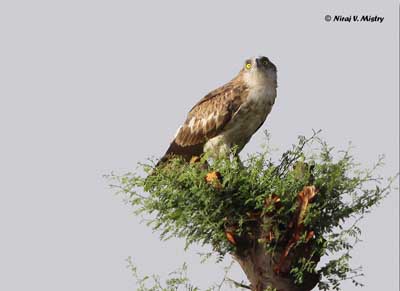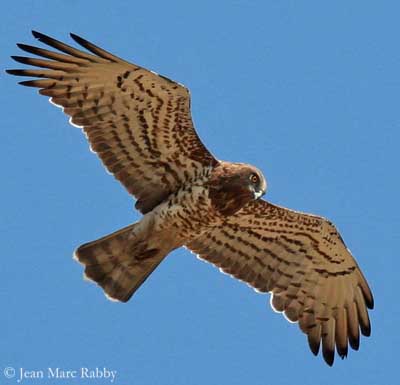
Fr: Circaète Jean le Blanc
All : Schlangenadler
Esp: Culebrera Europea
Ital: Biancone
Nd: Slangenarend
Sd: Ormörn
Photographers:
Niraj V. Mistry
Photo Galleries
Jean Marc Rabby
Des Ailes et des Plumes
Nicole Bouglouan
PHOTOGRAPHIC RAMBLE
Text by Nicole Bouglouan
Sources:
HANDBOOK OF THE BIRDS OF THE WORLD Vol 2 by Josep del Hoyo-Andrew Elliot-Jordi Sargatal - Lynx Edicions - ISBN: 8487334156
GUIDE DES RAPACES DIURNES – Europe, Afrique du Nord et Moyen-Orient de Benny Génsbol – Delachaux et Niestlé – ISBN : 2603013270
BIRDS OF PREY OF AFRICA AND ITS ISLANDS by Alan and Meg Kemp - Struik Publishers - ISBN: 1770073698
ENCYCLOPEDIE DES OISEAUX DE FRANCE ET D’EUROPE – de Peter Hayman et Rob Hume - Flammarion – ISBN : 2082009920
Pájaros de España (JL Beamonte)
BirdLife International (BirdLife International)
Short-toed Snake-Eagle
Circaetus gallicus
Accipitriforme Order – Accipitridae Family
BIOMETRICS:
Length: 62-67 cm
Wingspan: 170-185 cm
Weight: M: 1200-2000 g – F: 1300-2300 g
DESCRIPTION:
This beautiful raptor is an Old World species. The Short-toed Snake-Eagle is migratory, travelling southwards to Africa to spend the winter.
Both adults are similar, with female larger than male.
Adult has brown upperparts and white underparts, with dark brown head and upper breast. But the colours are rather variable.

In adults, the white underparts are usually barred dark brown on lower breast and belly, but also on the underwing. The trailing edge is dark brown, well visible in flight. The white undertail is barred brown.
But adults may have lighter underparts pattern with finer dark barring and paler upper breast.
On the upperwing, the flight feathers are dark brown. The uppertail feathers are brown barred darker.
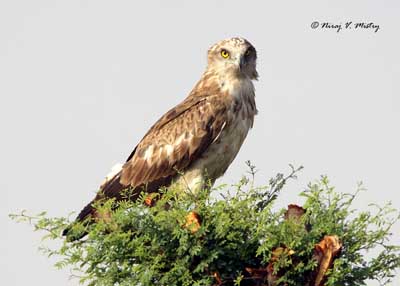
The head is brown and rounded. The hooked bill is relatively small and blackish with pale grey cere. Eyes are golden yellow. Legs and feet are dark grey. The long bare legs are covered with scales to protect the bird against the snake venom.
The juvenile resembles adult but it is usually paler with pale chestnut head and upper breast. On the underwing, the dark wing bars are paler.
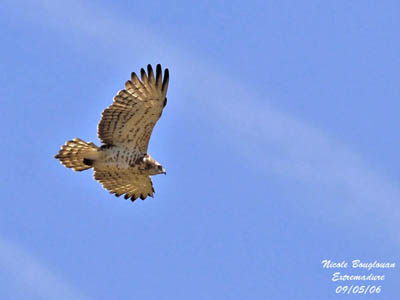
The immature have more contrasted underparts with dark brown bars on wings and tail. Head and upper breast become darker.
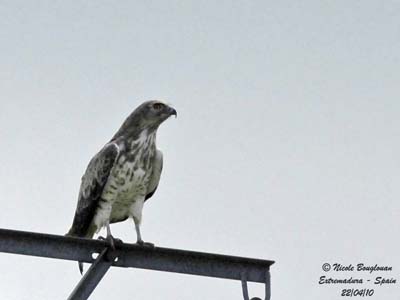
VOICE: SOUNDS BY XENO-CANTO
The Short-toed Snake-Eagle is noisy during the breeding season, and especially near the nest. We can also hear several kinds of calls such as a harsh, plaintive “jee”, a monotonous “peek-o” and a weaker “ok-ok-ok”.
During the displays, the male utters melodious sounds and clear, musical whistles, but the female rarely calls.
In aggressive encounters, it gives deep, harsh, repeated calls.
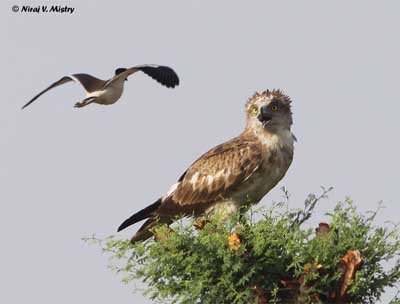
HABITAT:
The Short-toed Snake-Eagle is mainly found in warm and temperate areas, and in tropical regions. This species frequents open woodlands and can even be found in fairly dense forest and until semi-desert.
When hunting, it frequents mixed habitats with open areas such as stony surfaces with some vegetation, pastures and scrubs, providing numerous reptiles. But this raptor also needs tree cover such as small thickets or areas with scattered trees.
It can be seen hunting in plains, hills and mountains, and may hunt at high elevation, up to the tree-line and even higher according to the range.
It nests in wooded areas, both coniferous and deciduous woodlands.
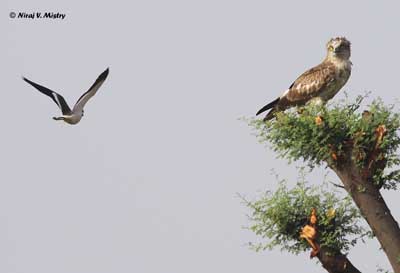
RANGE:
The Short-toed Snake-Eagle occurs throughout the Mediterranean Basin, northwards to the Gulf of Finland, and into Russia and Middle-East. It is also found in Indian subcontinent, Pakistan and some Indonesian islands.
The Palaearctic populations are migratory and numerous birds gather at famous points such as Straits of Gibraltar, southwards to Africa, and over Gulf of Suez between Asia and Africa.
All Indian populations are sedentary, as in Pakistan and on Lesser Sundas Islands.
The other populations winter in Tropical Africa, from Senegambia to Ethiopia. The eastern birds winter in India, and sometimes in SE Asia.
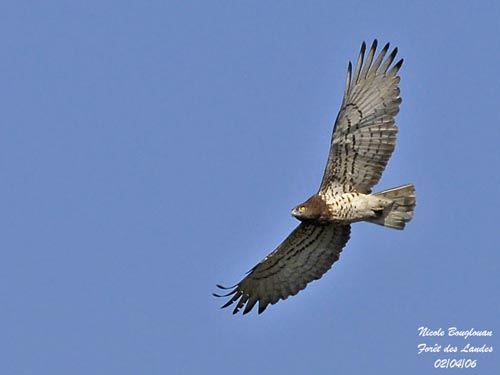
BEHAVIOUR:
The Short-toed Snake-Eagle feeds mainly on reptiles and primarily on snakes of variable sizes, but up to 1,50 to 1,80 metre of length. It takes usually non-venomous species (Colubridae). But it also catches lizards, chameleons, geckos, slow-worms and skinks (Scincidae).
It may occasionally take small mammals such as rodents, shrews, rabbits, hares and hedgehogs. It may catch sometimes amphibians, some birds and invertebrates. The preys vary according to the season.
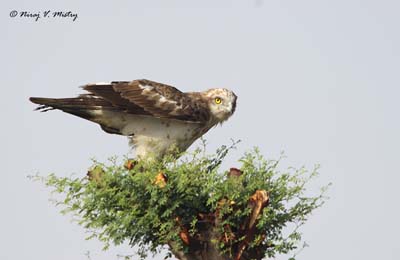
The Short-toed Snake-Eagle hunts mainly in open areas, foraging by gliding and soaring at medium height, but sometimes relatively high, usually between 20 and 150 metres and even more. When hunting, it hovers on the wind or performs wing-beats. When the prey is located, it flies down onto the snake with a short hover. It may also hunt from a perch.
Once captured, the snake is killed on the ground, sometimes while flying depending on the size. But usually, the Short-toed Snake-Eagle crushes or severs the head of the snake before to swallow it.

When an adult hunts for the chick, it carries the dead snake to the nest. We can see this raptor flying with the snake held in the bill.
The Short-toed Snake-Eagle is protected from the venom by scales on the legs, and thick plumage on thighs and body. In addition, it is very agile and rapid when catching snakes.
At the beginning of the breeding season, the pair returns to the same nest and usually, the nest is arranged or they often build a new nest.
This species is not aggressive or territorial, each bird or pair tends to ignore the other species or the neighbours.
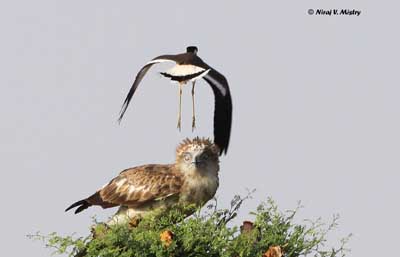
The courtship displays are simple. We can observe courtship feeding by male to the female while she prepares the nest. At this moment, both mates communicate by short whistles.
In aerial displays, the male soars, or performs series of undulating flights with repeated ascents and descents. Both mates may fly together.
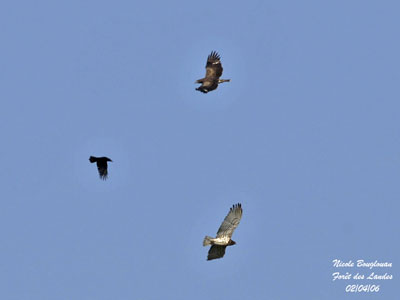
The Short-toed Snake-Eagle is sometimes mobbed by other species which consider the raptor as nest-predator, even if it rarely takes birds.
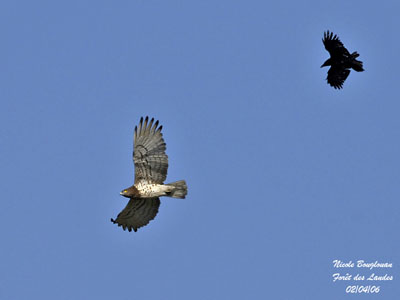
FLIGHT:
The Short-toed Snake-Eagle is powerful and has beautiful flight action. It soars over mountains and hills, often with dangling legs, while it watches for prey on the ground.
When hunting, it may perform dives from some height, up to 400 metres, onto a snake thanks to its keen sight.
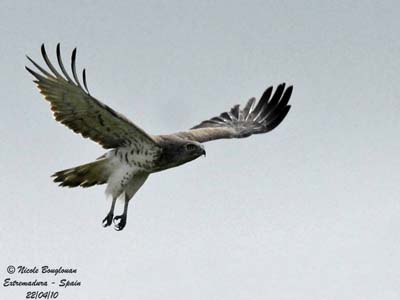

REPRODUCTION:
Breeding season occurs in spring (April) in Southern Europe and North Africa and in January-February in Indian subcontinent.
The Short-toed Snake-Eagle usually nests in trees, often a few metres above the ground, between 6 and 30 metres. It can use abandoned nests of other raptors or Corvids. The nest is placed on the tree-crown or on lateral branch.
It is a nest relatively small for the species, with about 50 cm of diameter. It is made with sticks and twigs, and the interior of the cup is lined with green leaves, grass or pine needles. Usually, a new nest is built each year.
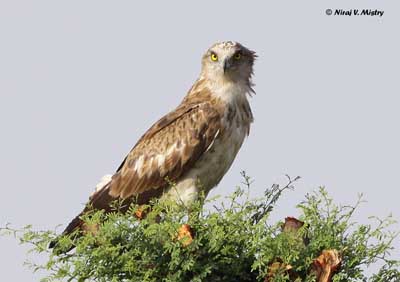
The female lays one large white egg. Incubation by female lasts about 45 days. During this period, she is fed by the male which remains close to the nest when it does not hunt.
The chick is fed by both parents and during the first three weeks, it is brooded by the female if the weather is bad. The male brings preys at nest, and the female tears to pieces and feeds the chick bill to bill.
At two months, the young is able to eat large snakes.
Both parents sleep in close tree until the young fledge, about 68-70 days after hatching. The female arranges the nest regularly and adds green sticks during the period.
Once fledged, the young still depends on adults and learns how to feed itself and to fly. It can breed at 3-4 years old.
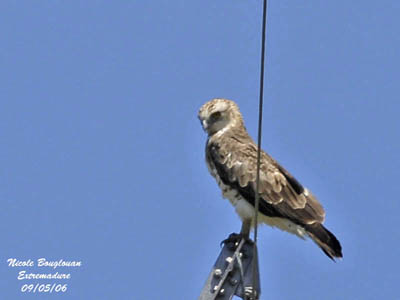
DIET:
The Short-toed Snake-Eagle feeds primarily on snakes of family Colubridae. The snake is caught by the nape and killed before to be carried to the nest.
It also takes other reptiles such as several species of lizards, and occasionally small mammals from rodents to hares, and some birds and invertebrates according to the season.
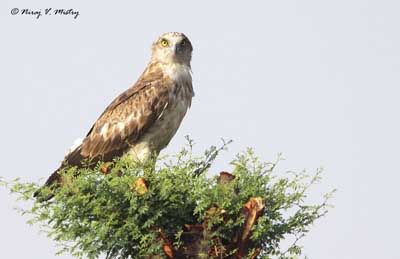
PROTECTION / THREATS / STATUS:
The Short-toed Snake-Eagle suffered declines in past, but the populations seem to be stable since the end of the 20th century.
This species has been less persecuted than other raptors, but the changes in the habitat from intensification of farming and deforestation may affect the populations of some countries.
According to the region, the Short-toed Snake-Eagle can be widespread and locally common, but generally it is sparsely distributed.
However, this species is not threatened at this moment.
